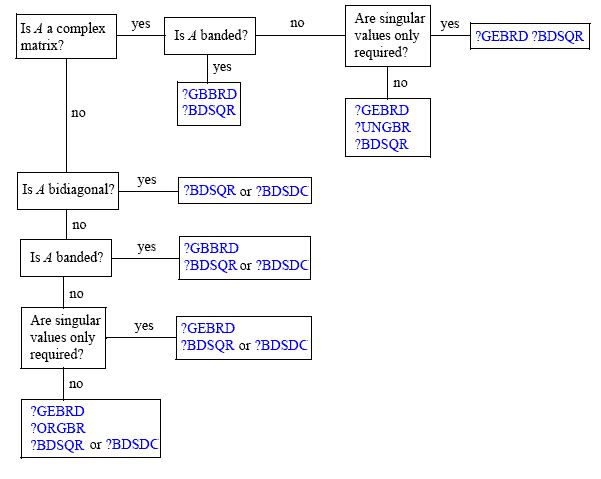This topic describes LAPACK routines for computing the singular value decomposition (SVD) of a general m-by-n matrix A:
A = UΣVH.
In this decomposition, U and V are unitary (for complex A) or orthogonal (for real A); Σ is an m-by-n diagonal matrix with real diagonal elements σi:
σ1≥σ2≥ ... ≥σmin(m, n)≥ 0.
The diagonal elements σi are singular values of A. The first min(m, n) columns of the matrices U and V are, respectively, left and right singular vectors of A. The singular values and singular vectors satisfy
Avi = σiui and AHui = σivi
where ui and vi are the i-th columns of U and V, respectively.
To find the SVD of a general matrix A, call the LAPACK routine ?gebrd or ?gbbrd for reducing A to a bidiagonal matrix B by a unitary (orthogonal) transformation: A = QBPH. Then call ?bdsqr, which forms the SVD of a bidiagonal matrix: B = U1ΣV1H.
Thus, the sought-for SVD of A is given by A = UΣVH =(QU1)Σ(V1HPH).
Table "Computational Routines for Singular Value Decomposition (SVD)" lists LAPACK routines that perform singular value decomposition of matrices.
Operation |
Real matrices |
Complex matrices |
|---|---|---|
Reduce A to a bidiagonal matrix B: A = QBPH (full storage) |
||
Reduce A to a bidiagonal matrix B: A = QBPH (band storage) |
||
Generate the orthogonal (unitary) matrix Q or P |
||
Apply the orthogonal (unitary) matrix Q or P |
||
Form singular value decomposition of the bidiagonal matrix B: B = UΣVH |
Decision Tree: Singular Value Decomposition

Figure "Decision Tree: Singular Value Decomposition" presents a decision tree that helps you choose the right sequence of routines for SVD, depending on whether you need singular values only or singular vectors as well, whether A is real or complex, and so on.
You can use the SVD to find a minimum-norm solution to a (possibly) rank-deficient least squares problem of minimizing ||Ax - b||2. The effective rank k of the matrix A can be determined as the number of singular values which exceed a suitable threshold. The minimum-norm solution is
x = Vk(Σk)-1c
where Σk is the leading k-by-k submatrix of Σ, the matrix Vk consists of the first k columns of V = PV1, and the vector c consists of the first k elements of UHb = U1HQHb.